1 Scope
2 Normative references
3 Terms, definitions, symbols and abbreviated terms
3.1 Terms and definitions
3.2 Symbols and abbreviated terms
3.3 Conventions
4 Introduction
4.1 System description
4.2 DASH client model
4.3 DASH data model overview
4.4 Protocols
4.5 Media Stream and Representation properties
4.5.1 Switching and Random Access Support
4.5.2 Media stream access points
4.5.3 Non-overlapping Segments and Subsegments
4.5.4 Bitstream concatenation
4.6 Brands
4.7 Schemes
5 Media Presentation
5.1 General
5.2 Media Presentation Description
5.2.1 General
5.2.2 Schema
5.2.3 Elements and Attributes added in Revisions and Amendments
5.2.3.1 Overview
5.2.3.2 Elements and Attributes added in this Revision
5.3 Hierarchical data model
5.3.1 Introduction
5.3.1.1 Overview
5.3.1.2 Semantics
5.3.1.3 XML syntax
5.3.2 Period
5.3.2.1 Overview
5.3.2.2 Semantics
5.3.2.3 XML syntax
5.3.3 Adaptation Sets
5.3.3.1 Overview
5.3.3.2 Semantics
5.3.3.3 XML syntax
5.3.4 Media Content Component
5.3.4.1 Overview
5.3.4.2 Semantics
5.3.4.3 XML syntax
5.3.5 Representation
5.3.5.1 Overview
5.3.5.2 Semantics
5.3.5.3 XML syntax
5.3.6 Sub-Representation
5.3.6.1 Overview
5.3.6.2 Semantics
5.3.6.3 XML syntax
5.3.7 Common attributes and elements
5.3.7.1 Overview
5.3.7.2 Semantics
5.3.7.3 XML syntax
5.3.8 Subsets
5.3.8.1 Overview
5.3.8.2 Semantics
5.3.8.3 XML syntax
5.3.9 Segments and Segment information
5.3.9.1 General
5.3.9.2 Segment base information
5.3.9.2.1 Overview
5.3.9.2.2 Semantics
5.3.9.2.3 XML-Syntax
5.3.9.3 Segment list
5.3.9.3.1 Overview
5.3.9.3.2 Semantics
5.3.9.3.3 XML-Syntax
5.3.9.4 Segment template
5.3.9.4.1 Overview
5.3.9.4.2 Semantics
5.3.9.4.3 XML syntax
5.3.9.4.4 Template-based Segment URL construction
5.3.9.5 Segment information
5.3.9.5.1 Overview
5.3.9.5.2 Initialization Segment information
5.3.9.5.3 Media Segment information
5.3.9.5.4 Index Segment information
5.3.9.5.5 Bitstream Switching Segment information
5.3.9.6 Segment timeline
5.3.9.6.1 General
5.3.9.6.2 Semantics
5.3.9.6.3 XML syntax
5.4 Media Presentation Description updates
5.5 MPD assembly
5.5.1 Introduction
5.5.2 Syntax and semantics
5.5.3 Processing
5.6 Base URL Processing
5.6.1 Overview
5.6.2 Semantics
5.6.3 XML syntax
5.6.4 Reference resolution
5.6.5 Alternative base URLs
5.7 Program information
5.7.1 Overview
5.7.2 Semantics
5.7.3 XML syntax
5.8 Descriptors
5.8.1 General
5.8.2 Semantics of generic descriptor
5.8.3 XML syntax of generic descriptor
5.8.4 Specific descriptors
5.8.4.1 Content protection
5.8.4.2 Role
5.8.4.3 Accessibility
5.8.4.4 Rating
5.8.4.5 Viewpoint
5.8.4.6 Frame-packing
5.8.4.7 Audio channel configuration
5.8.4.8 Essential Property Descriptor
5.8.4.9 Supplemental Property Descriptor
5.8.4.10 Asset Identifier
5.8.5 Specific scheme definitions
5.8.5.1 General
5.8.5.2 Content protection
5.8.5.3 Frame-packing
5.8.5.4 Audio channel configuration schemes
5.8.5.5 DASH role scheme
5.8.5.6 DASH Multiple views scheme
5.9 DASH metrics descriptor
5.9.1 Overview
5.9.2 Semantics
5.9.3 XML syntax
5.9.4 Metric reporting
5.10 Events
5.10.1 Overview
5.10.2 MPD Events
5.10.2.1 Overview
5.10.2.2 Semantics
5.10.2.3 XML-Syntax
5.10.3 Inband Event Signalling
5.10.3.1 Overview
5.10.3.2 MPD Signalling
5.10.3.3 Event message box
5.10.3.3.1 Introduction
5.10.3.3.2 Definition
5.10.3.3.3 Syntax
5.10.3.3.4 Semantics
5.10.3.3.5 Carriage of the Event Message Box in MPEG-2 TS
5.10.4 DASH-specific events
5.10.4.1 Overview
5.10.4.2 MPD validity expiration
6 Segment formats
6.1 Introduction
6.2 Segment types
6.2.1 Introduction
6.2.2 Initialization Segment
6.2.3 Media Segment
6.2.3.1 General
6.2.3.2 Subsegments and Segment Index
6.2.3.3 Subsegment Index
6.2.4 Index Segment
6.2.5 Bitstream Switching Segment
6.3 Segment formats for ISO base media file format
6.3.1 Introduction
6.3.2 Preliminaries: Refinements of generic concepts
6.3.2.1 Subsegments
6.3.2.2 Media stream access points
6.3.2.3 Segment Index
6.3.2.4 Subsegment Index
6.3.3 Initialization Segment format
6.3.4 Media Segment types
6.3.4.1 General
6.3.4.2 General format type
6.3.4.3 Indexed Media Segment
6.3.4.4 Sub-Indexed Media Segment
6.3.5 Self-Initializing Media Segment formats
6.3.5.1 General format type
6.3.5.2 Indexed self-initializing Media Segment
6.4 Segment formats for MPEG-2 transport streams
6.4.1 Introduction
6.4.2 Preliminaries: Refinements of generic concepts
6.4.2.1 Subsegment
6.4.2.2 Media stream access points
6.4.2.3 Segment Index
6.4.2.4 Subsegment Index
6.4.3 Initialization Segment types and formats
6.4.3.1 Initialization information
6.4.3.2 Initialization Segment
6.4.4 Media Segment types and formats
6.4.4.1 General
6.4.4.2 Basic Media Segment
6.4.4.3 Content Protection
6.4.4.4 Self-initializing Media Segment
6.4.5 Bitstream Switching Segment
6.4.6 Index Segment
6.4.6.1 General
6.4.6.2 Single Index Segment
6.4.6.3 Representation Index Segment
6.4.6.4 Subsegment Index Segment
6.4.7 Boxes used with MPEG-2 TS Index Segments
6.4.7.1 Introduction
6.4.7.2 MPEG-2 TS PCR information box
6.4.7.2.1 Definition
6.4.7.2.2 Syntax
6.4.7.2.3 Semantics
7 Combined semantics of MPD and Segment formats
7.1 Introduction
7.2 General
7.2.1 Media Presentation timeline
7.2.2 Segment Index
7.2.3 Segment alignment
7.2.4 Subsegment alignment
7.3 Media Presentation based on the ISO base media file format
7.3.1 General
7.3.2 Media presentation timeline
7.3.3 Authoring Rules for specific MPD attributes
7.3.3.1 Segments starting with media stream access points
7.3.3.2 Bitstream switching
7.3.4 Sub-Representations
7.4 Media Presentation based on MPEG-2 TS
7.4.1 Introduction
7.4.2 Media presentation timeline
7.4.3 Authoring rules for specific MPD attributes
7.4.3.1 Segments starting with Media stream access points
7.4.3.2 Segment alignment
7.4.3.3 Subsegment alignment
7.4.3.4 Bitstream switching
7.4.4 Sub-Representations
8 Profiles
8.1 Definition
8.2 Full profile
8.2.1 General
8.2.2 Media Presentation Description constraints
8.2.3 Segment format constraints
8.3 ISO Base media file format On Demand profile
8.3.1 General
8.3.2 Media Presentation Description constraints
8.3.3 Segment format constraints
8.4 ISO Base media file format live profile
8.4.1 General
8.4.2 Media Presentation Description constraints
8.4.3 Segment format constraints
8.5 ISO Base media file format main profile
8.5.1 General
8.5.2 Media Presentation Description constraints
8.5.3 Segment format constraints
8.6 MPEG-2 TS main profile
8.6.1 General
8.6.2 Media Presentation Description constraints
8.6.3 Segment format constraints
8.6.4 Comments and recommendations
8.7 MPEG-2 TS simple profile
8.7.1 General
8.7.2 Media Presentation Description constraints
8.7.3 Segment format constraints
8.7.4 Recommendations


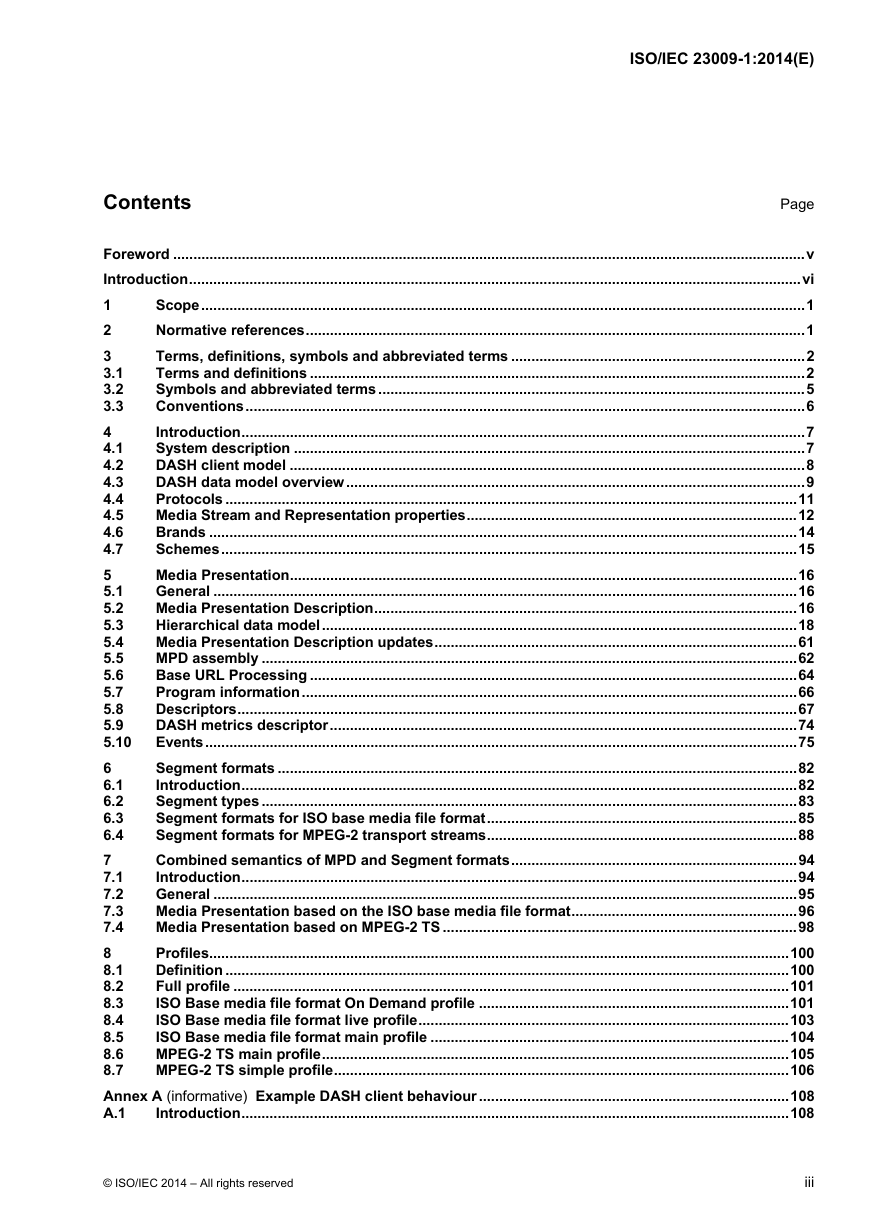
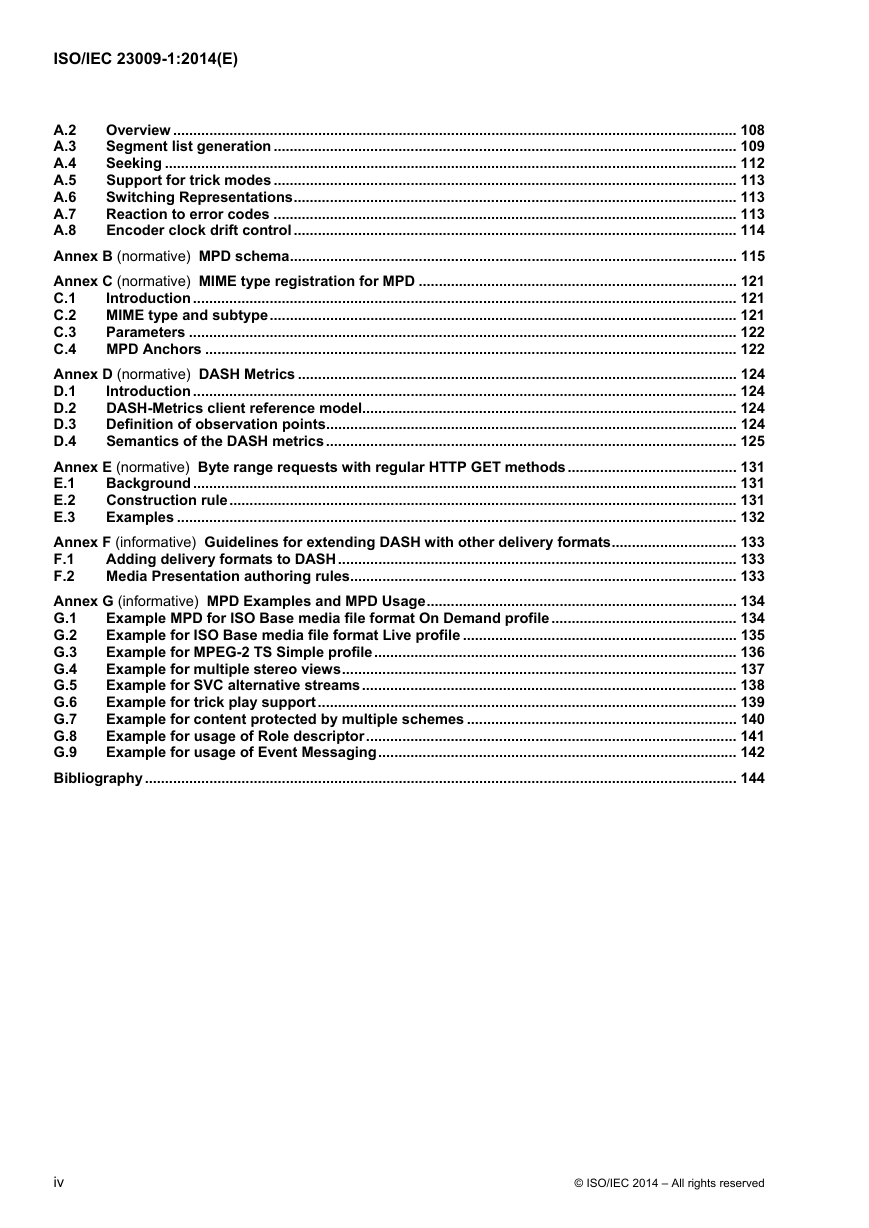
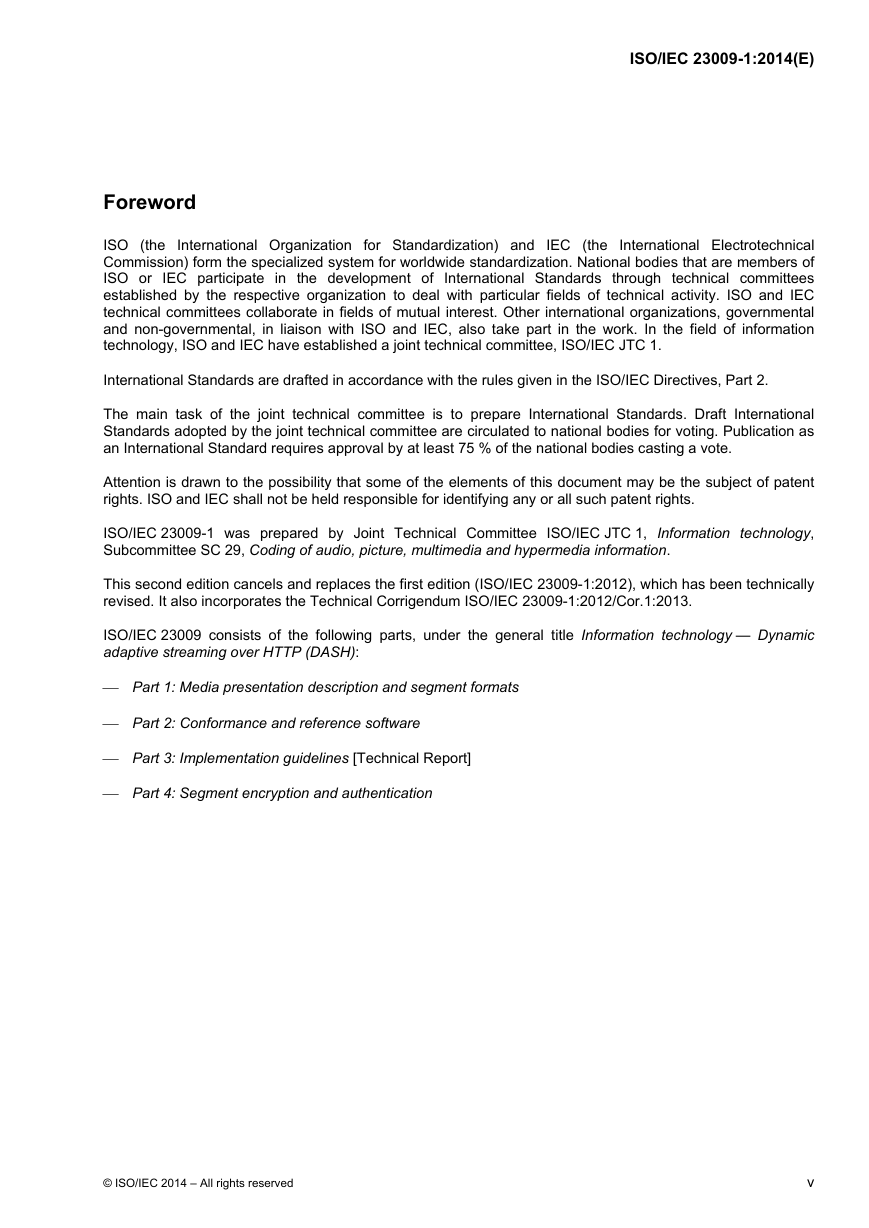
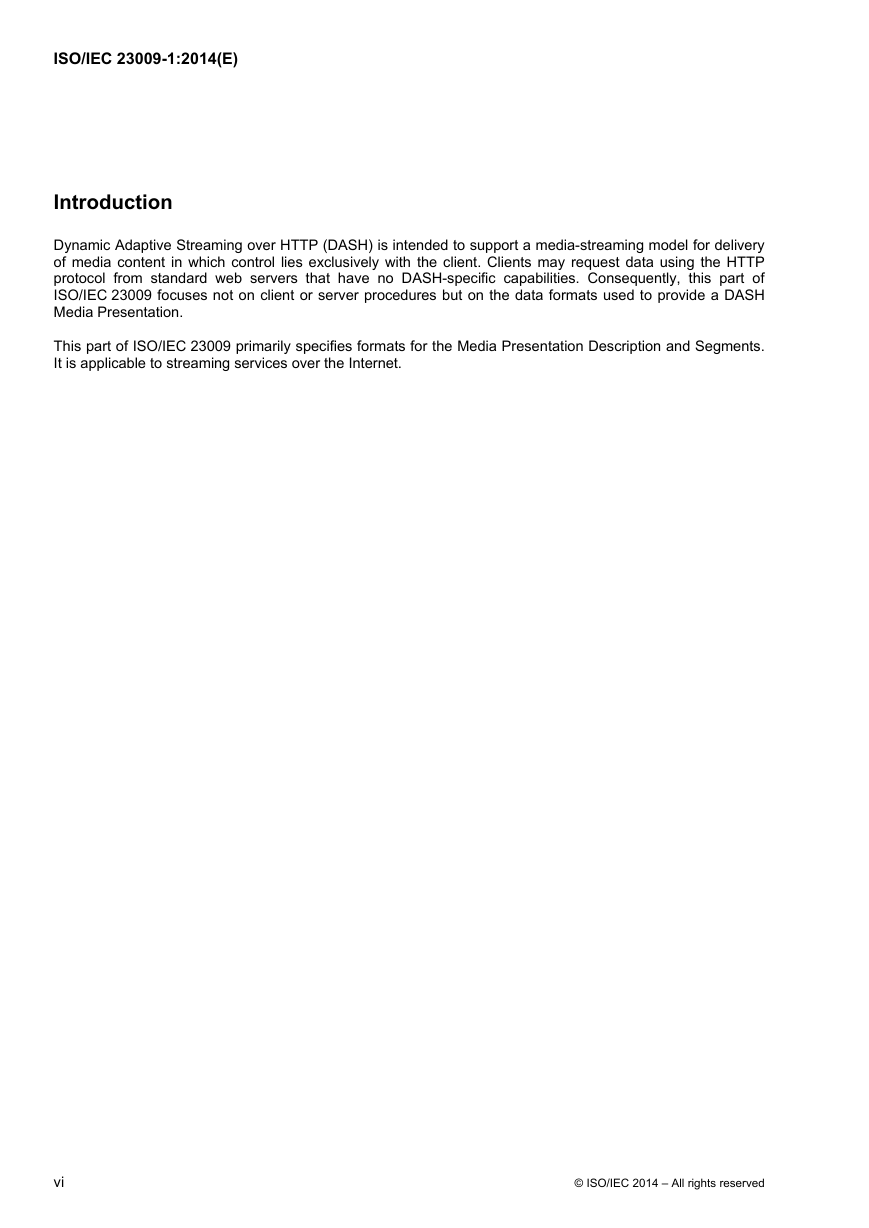
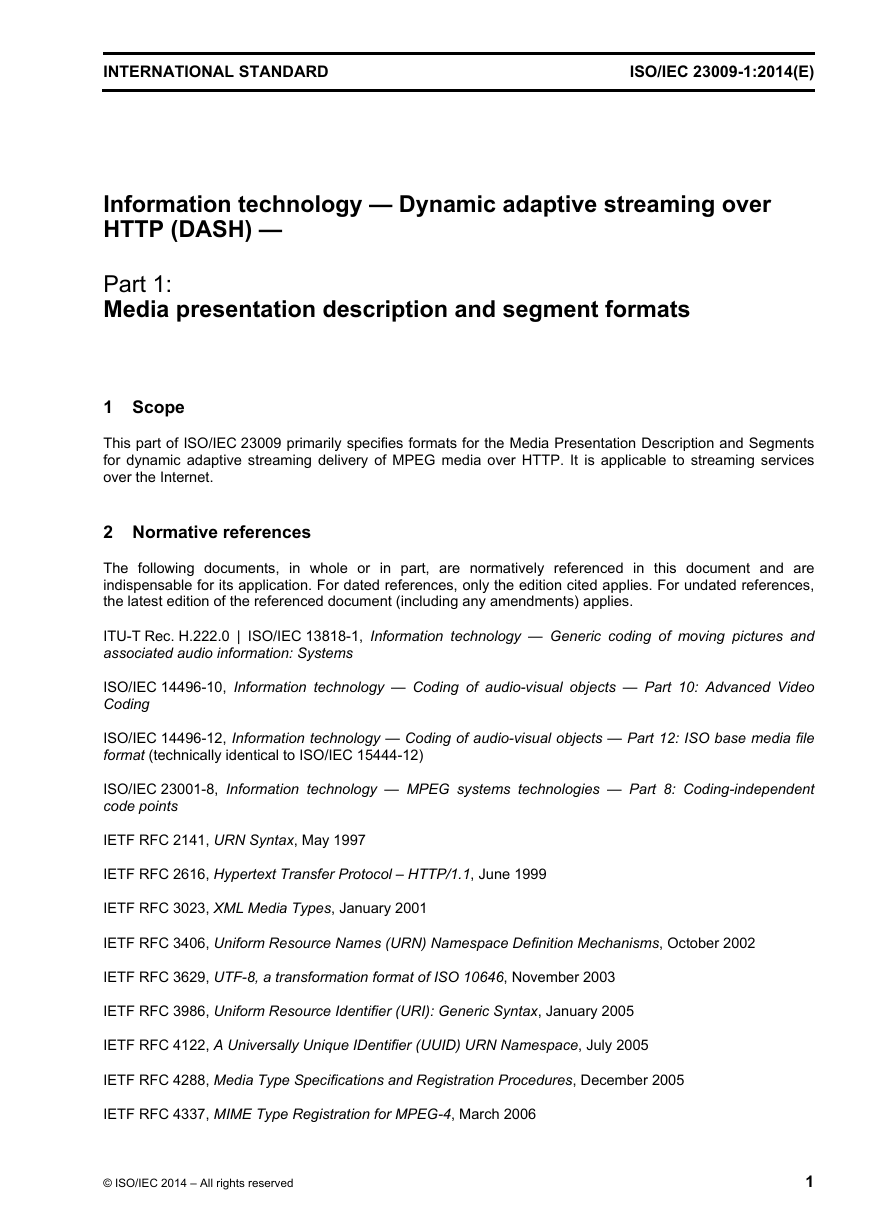









 2023年江西萍乡中考道德与法治真题及答案.doc
2023年江西萍乡中考道德与法治真题及答案.doc 2012年重庆南川中考生物真题及答案.doc
2012年重庆南川中考生物真题及答案.doc 2013年江西师范大学地理学综合及文艺理论基础考研真题.doc
2013年江西师范大学地理学综合及文艺理论基础考研真题.doc 2020年四川甘孜小升初语文真题及答案I卷.doc
2020年四川甘孜小升初语文真题及答案I卷.doc 2020年注册岩土工程师专业基础考试真题及答案.doc
2020年注册岩土工程师专业基础考试真题及答案.doc 2023-2024学年福建省厦门市九年级上学期数学月考试题及答案.doc
2023-2024学年福建省厦门市九年级上学期数学月考试题及答案.doc 2021-2022学年辽宁省沈阳市大东区九年级上学期语文期末试题及答案.doc
2021-2022学年辽宁省沈阳市大东区九年级上学期语文期末试题及答案.doc 2022-2023学年北京东城区初三第一学期物理期末试卷及答案.doc
2022-2023学年北京东城区初三第一学期物理期末试卷及答案.doc 2018上半年江西教师资格初中地理学科知识与教学能力真题及答案.doc
2018上半年江西教师资格初中地理学科知识与教学能力真题及答案.doc 2012年河北国家公务员申论考试真题及答案-省级.doc
2012年河北国家公务员申论考试真题及答案-省级.doc 2020-2021学年江苏省扬州市江都区邵樊片九年级上学期数学第一次质量检测试题及答案.doc
2020-2021学年江苏省扬州市江都区邵樊片九年级上学期数学第一次质量检测试题及答案.doc 2022下半年黑龙江教师资格证中学综合素质真题及答案.doc
2022下半年黑龙江教师资格证中学综合素质真题及答案.doc